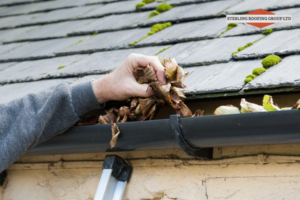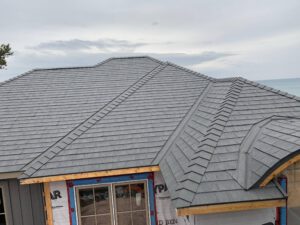The roof protects our homes and buildings year-round but is often overlooked unless something goes wrong. Keeping consistent roofing maintenance schedules prevents minor problems from escalating into major issues that require costly repairs or replacements.

Roofs are prone to extreme weather conditions that can cause damage and impact the life expectancy of the roofing materials. Regular roof inspections can help identify developing issues.
A home’s soffit and fascia are crucial to its overall structure. They protect the overhang of a roof from moisture and mold; they provide ventilation for attic spaces; and they shield the ends of rafters. The soffit and fascia can take quite a beating from weathering, so it’s important to check for signs of damage regularly.
Moisture damage to a soffit or fascia can lead to rot and wood deterioration, which in turn leads to more serious problems for the rest of the roof system. Often the first sign of fascia or soffit problems is paint that begins to crack and peel, which is a clear indication that moisture has begun compromising the integrity of those structures.
The soffit and fascia are also important defenses against pests, as they are designed to serve as an effective barrier to both bugs and rodents. These pests can harm a roof system more quickly than almost any other factor, as they can breed, gnaw at wires and insulation, and leave behind excrement that can be a health hazard for the occupants of the house. In addition, if the soffit and fascia are compromised by pests, it may be necessary to hire a professional termite removal service before hiring someone to repair the fascia or soffit.
As a homeowner, you should regularly inspect the fascia and soffit for any signs of damage or deterioration. Taking the time to do so can help you avoid expensive repairs in the future.
The soffit and fascia are essential to the overall function of a roof system, as they shield the overhang from moisture and mold, prevent rainwater from entering the house, and provide attic ventilation. If you suspect that your soffit or fascia is damaged or needs to be replaced, contact a roofing company for more information. The company will be able to provide a free estimate for the work and can make any necessary repairs to ensure the safety of your home’s roof. In most cases, a roof leak is caused by a failing soffit or fascia board, so it’s important to get these structures fixed immediately.
Inspect the gutters.
Gutter systems are installed along the edge of a roof to capture and direct runoff. However, they can get clogged with leaves and debris that block the flow of water. As a result, puddling occurs around the edges of the house, and foundation damage can occur. Gutters and downspouts must be inspected regularly to ensure they’re functioning properly.
It’s best to have a skilled gutter-cleaning and inspection expert handle this task, as climbing on the roof and working from a ladder is a dangerous undertaking. Even if homeowners take all the necessary precautions, such as putting a ladder on level ground and stabilizing it with bricks or sandbags, they can still be injured.
Ideally, homeowners should have their gutters inspected twice a year. During these visits, they should look for signs of problems such as:
Are the gutters loose or detached? Loose or detached gutters can easily fall off during severe weather conditions. This is extremely dangerous for anyone on the ground below, but it can also lead to damage to wood items such as fascia boards and soffits. It can also cause the ground to erode, which can further compromise the structural integrity of the home.
Another thing to check is whether the gutters are rusty or corroded. If the gutters are rusty or leaking, they should be repaired immediately. Similarly, if the downspouts are leaking or clogged, they should be cleaned and replaced.
Homeowners should also check the eavestroughs for dents and cracks. If the eavestroughs are damaged, it’s likely that the siding and windowsills will be affected too. Moreover, the dents can indicate that the gutters, or worse, the roof, might be damaged.
During this inspection, homeowners should also look for signs of mold and mildew on the roof and around the gutters. If mold or mildew is found, it’s a good idea to contact a local roofing contractor in Schaumburg right away to have the problem addressed before it becomes worse. It’s important to note that mold and mildew aren’t just cosmetic issues; they can also compromise the structure of the roof, which could lead to a costly repair bill in the future.
Inspect the flashing
The flashing protects the edges of your roof and any penetrations, such as chimneys, pipes, or skylights. It directs water away from these areas and helps prevent leaks, wood rot, and structural damage to the building. It also helps to extend the life of your roofing materials.
If you have a leaky roof, it is likely because of a problem with the flashing. During your inspection, look for any signs of flash damage or degradation. This can include openings, cracking, deterioration, or crazing of the sealant. These issues are a sign that the flashing is failing and needs to be replaced. If you don’t fix the flashing, it can allow water into your home, which can lead to water damage and even mold growth.
It’s important to check the flashing regularly, particularly in cold weather. Winter conditions are hard on flashing and can cause problems like ice dams and snow buildup. In addition to checking for deteriorating or damaged flashing, it is also important to ensure that the flashing is properly installed. A professional roofer will know how to install and repair the flashing correctly.
You can check the flashing from the ground or a window, but you will need a ladder large enough to reach the roof. Be sure to use caution when climbing the ladder and be careful of the slope of the roof. If your roof is too steep to climb safely, a professional should be hired to inspect the flashing.
While flashing is not always the source of leaks, it’s one of the most common places for them to develop. Leaks can be caused by a variety of factors, including faulty installation or the aging of the material. Leaks can also be the result of hail damage or the movement of a chimney or structure.
When examining the flashing, you should check for corrosion and any holes or gaps. In particular, you should pay attention to the flashing where it meets a vertical wall. Chimney flashing is made of metal strips that overlap each other and are then nailed to the walls. It is important that the flashing is nailed securely and has a solid seal with the wall.
Trim tree branches
The branches of trees and shrubs that hang over your roof can cause a number of problems. They can break and fall during a storm or simply become tangled in your gutters and roof. This can lead to a buildup of snow or moisture that could damage the shingles, leading to rot and leaks.
Trimming tree branches helps you keep them from falling on your roof during a storm and also keeps leaves and other debris from piling up and absorbing water that could damage the shingles. It can even keep squirrels and other critters from accessing the roof, where they might cause more damage.
When trimming a branch, start by sawing into the underside of it. This will make the limb easier to remove, and it prevents the bark from being ripped off during the cut. Next, saw into the top side of the limb, moving away from the stem of the branch. Finally, saw into the stub that remains, cutting flush with the branch collar. This ensures that the wound seals properly and won’t be infested by decay fungi that can lead to structural damage.
You should never prune a tree without first consulting a professional, especially when dealing with large, mature trees. One wrong cut won’t kill a tree immediately, but repeated pruning mistakes can cause serious damage that will eventually result in death.
While it is important to thin a tree, you should not remove more than 25% of the canopy at one time. This is called “topping,” and it can be very damaging to a tree. Topping can lead to poor form and structural weakness, as well as weakening the root system and exposing it to disease and insect infestation.
To reduce the risk of disease and insect invasion, it is best to remove damaged limbs as soon as they’re discovered. This can help minimize the spread of the infection and promote a faster recovery. In addition, you should clean up the jagged remains of broken branches with a utility knife to help improve their appearance and eliminate hiding places for insects.

